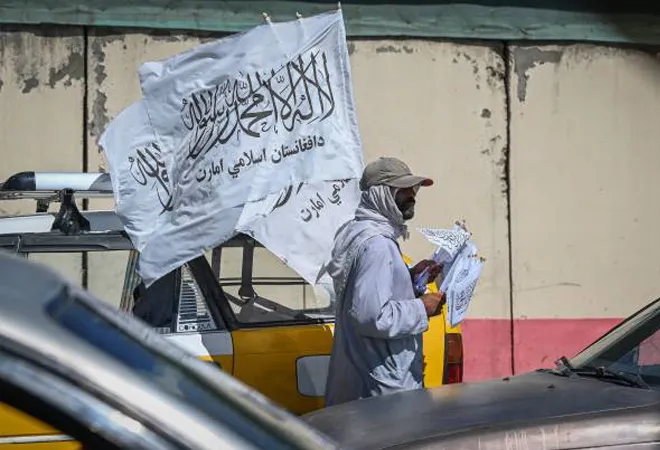-
CENTRES
Progammes & Centres
Location

Almost 10 months since the Taliban took over Kabul, India is steadily increasing its engagements and outreach with the group. Over the past few months, New Delhi has tested the waters with the Taliban by making calculated and lowkey moves to engage with the group’s interim government, while continuing discussions with regional and international actors alike. Talks about reopening a section of the embassy in Kabul have been reported while a regional summit on Afghanistan orchestrated by India was held in November 2021. The criticality of the Afghanistan crisis within the international community suffered setbacks in the face of the ongoing war in Ukraine. However, Delhi has tried to keep the issue on the frontburner in almost all its engagements with international partners.
For the ambit of this article, three major events conducted by New Delhi illustrate the kind of outreach India has conducted with the Taliban, and their outcomes.
The criticality of the Afghanistan crisis within the international community suffered setbacks in the face of the ongoing war in Ukraine.
First, days after the fall of Kabul, India’s ambassador to Qatar, Deepak Mittal, met Taliban leader Sher Mohammed Abbas Stanekzai in Doha. The meet was requested by the Taliban, and took place at the Indian embassy, and not on neutral soil. This was a message in itself, of India engaging, but on its own terms. Stanekzai is known to India as he completed his military training in Dehradun in the 1980s when part of the Afghan armed forces. This meeting also tested another major area of concern, that of domestic political reactions to engagements with the Taliban. In Kashmir, Mehbooba Mufti asked if India could talk to the Taliban, then why not to Pakistan? While strategically engaging with the Taliban is a realistic move, domestically, especially with the current government’s own ideological bend, it is a proposition easier said than done.
The second significant case of outreach went largely under the radar as it happened a few hours after Russia launched military operations against Ukraine. On February 26, wheat aid for the Afghan people provided by India reached Jalalabad by land via Pakistan. The route of this aid was a test case for Delhi itself, which clearly forced the Taliban to push Pakistan to allow aid trucks to use the land route. Upon the aid’s arrival, the Taliban posted pictures of the welcome ceremony with both the Indian and Taliban flags side by side.
This was not an impromptu or opportunistic decision forced upon us by the Taliban but had the Indian establishment’s approval. This overt display of access, humanitarian cooperation, and a level of organisational capability was a signal for India’s engagement and presence despite the on-ground reality. Over time, India committed to providing more than 50,000 metric tonnes of wheat to the struggling people of Afghanistan, continuing its traditional role of being a development partner. Since then, Taliban leaders such as Anas Haqqani, Qahar Balkhi, Zabiullah Mujahid have also been interviewed by Indian news channels.
India committed to providing more than 50,000 metric tonnes of wheat to the struggling people of Afghanistan, continuing its traditional role of being a development partner.
The third notable event was seen in the recent visit of Abdullah Abdullah, who led the High Council for National Reconciliation (HCNR) and was previously the chief executive officer of Afghanistan, to Delhi – the first time he was allowed to leave Afghanistan since the Taliban took charge. While the trip was personal, the Taliban may not have allowed Abdullah to leave if it feared negative outcomes for its own interests. In fact, the Taliban could have used this opportunity to deliver communications to India. During his visit, other than in all likelihood meeting Indian officials, Abdullah also met US Special Representative for Afghanistan, Thomas West, adding more weight to a hypothesis that all these engagements were in concert, and not by chance. During this same time, the Taliban denied former president Hamid Karzai permission to visit Abu Dhabi to offer his condolences on the recent passing of the United Arab Emirates’ president, Sheikh Khalifa bin Zayed Al Nahyan.
From an Indian perspective, the approach to Afghanistan remains very fluid and led by a hard security posture than a diplomatic one. An uptick in seizures of narcotic shipments and filtration of weapons, including western ones, from Afghanistan into Kashmir remain areas of immediate concern. It is imperative to remember that engagement does not translate into recognition of this new reality and that every regional and international stakeholder continues to keep all their options open.
However, engagement at certain levels for India with the Taliban is inevitable and a need of the hour for its own geopolitical and strategic interests, as it was in the 1990s.
This commentary originally appeared in Hindustan Times.
The views expressed above belong to the author(s). ORF research and analyses now available on Telegram! Click here to access our curated content — blogs, longforms and interviews.